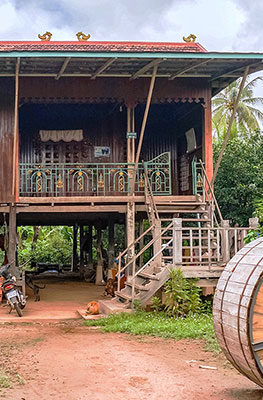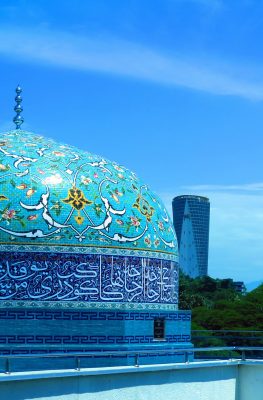Published on February 15, 2023
Culturally eclectic and geologically awe-inspiring, the Philippines is home to some of the world’s most impressive natural wonders. This archipelagic Southeast Asian nation is made up of over 7,000 islands, each of which has its own distinct attractions and identity.
Boasting looming volcanoes, gorgeous spits of sand, and mysterious underwater terrain, the Philippines is an endless well of discovery. The country also has a fascinating culture and history, due to a combination of centuries-old traditions over 350 years of Spanish rule. Beaches, fiestas, old churches, coral reefs — all of this and more awaits visitors to this diverse nation.
Whether you are looking for a seaside holiday or a rainforest expedition; city living or a few nights in the mountains, there is something for everyone in this unique archipelago. Here are five of the most incredible natural wonders of the Philippines.
Tubbataha Reefs Natural Park
A sea turtle in the Tubbataha Reefs | Visit Southeast Asia
A protected area in the heart of the Sulu Sea, the Tubbataha Reefs are some of the most pristine reefs and wetlands in the world. The Tubbataha reefs are situated along a ridge of extinct underwater volcanoes whose past activity contributed to the impressive biodiversity of the area. This underwater wildlife sanctuary is home to more than 600 species of fish, 360 species of coral, and countless more species of sharks, whales, and dolphins.
The name Tubbataha comes from the nomadic Sama-Bajau people, who sail and fish in the area. It is a UNESCO World Heritage Site, and offers about a dozen different dive sites, where divers can revel in the park’s beautiful waters and myriad aquatic animals. Those not trained in scuba diving can also enjoy the sights by snorkeling.
The best way to get to Tubbataha is by taking a boat from Puerto Princesa, the capital of Palawan. Usual dive tours are about 5-7 days long, and visitors sleep on their boats for the duration.
This iconic oceanic destination is perfect for diving aficionados — almost nowhere else on Earth will you be able to see such a wealth of aquatic life. This alone makes the Tubbataha Reefs one of the most impressive natural wonders of the Philippines.
Rice Terraces
The rice terraces of Cordilleras | Visit Southeast Asia
One of the world’s most breathtaking agricultural sites, the rice terraces of the Philippines’ Cordilleras region is an absolute must-visit. These fascinating cultural creations are found on the island of Luzon, where they are separated into five distinct sites. The sloping terraces were hand-carved into the natural contours of the island’s hills and mountains, and buffeted by stone and mud walls. The early tribes that built them also created a complex irrigation system that transports water from the mountaintop down across the fields.
The creation of the area stretches back about a thousand years, long before the Philippines became the unified nation it is now. Historians believe the terraces were first used by the tribes of the Cordillera to plant taro, but it was replaced by rice circa the 1600s. The Cordilleras Rice Terraces are considered National Cultural Treasures by the Filipino government, and certain sections are also UNESCO World Heritage Sites.
The greenery is at its peak between April and May and then October and November, making those periods the best times to visit the area. The Cordilleras are relatively remote – about a 8 or 9 hour bus ride from Manila, so one option for visiting the terraces is to take a night bus to the area.
Great Santa Cruz Island
Pink sand at Great Santa Cruz Island | Visit Southeast Asia
Great Santa Cruz Island in the southern Philippines is famous for its pink sand — something so rare that only a few other beaches in the world can boast the same. The unique color comes from red organ pipe corals mixing with white sand over time. In 2017, National Geographic named Great Santa Cruz Island one of the 21 Best Beaches in the World.
The local Zamboanga City government limits visits to the pink beach to the daytime, meaning visitors cannot stay overnight, but there are cottages by the beach open for daytime rental. Despite the time restrictions, this pink beach remains super popular for its rare beauty. There are also many other activities to do in and around Great Santa Cruz Island, from mangrove cruises, snorkeling, and trying local seafood.
The easiest way to get to Great Santa Cruz Island is to fly into the Zamboanga airport, before catching a ride to Paseo del Mar, the jumping-off point for a boat trip to the island. Visitors looking for a completely unique beach experience will love the pink hue of Great Santa Cruz.
Puerto Princesa Subterranean River National Park
Puerto Princesa Subterranean River National Park | Visit Southeast Asia
Yet another UNESCO World Heritage Site, the Puerto Princesa Subterranean River National Park is one of the most spectacular sights of the Philippines. It has been voted one of the 7 New Wonders of the World, and for good reason. The park encompasses the cave system through which the underground river flows, as well as 50,000-plus acres of immaculate old-growth forests.
Located about 80 kilometers north of Puerto Princesa, Palawan, the park is home to the world’s second-largest subterranean river. The underground portion of the river measures in at 8.2 kilometers, and at some points in the cave, it forms two layers — causing spectacular underground waterfalls.
Intrepid explorers and casual tourists alike will love this fascinating natural attraction. Its relatively central location and its unique nature make it one of the Philippines’ best destinations.
Chocolate Hills
The Chocolate Hills | Visit Southeast Asia
Ever seen mountains that look like Hershey’s Kisses? That’s what awaits visitors at the Chocolate Hills of Bohol – one of the most famous natural wonders of the Philippines. Though they are covered in verdant greenery in the spring and fall, they dry up into a warm orangey-brown in the dry season, giving them the hue of chocolate. There are as many as 1,700 hills in the area, covering about 50 square kilometers in the province.
The majority of these conical hills are symmetrical, offering geologists a prime example of limestone topography. The commonly accepted explanation for their formation is that they came from rising coral deposits, but many people continue to come up with their own theories. A few of the hills have been turned into resorts, making them the perfect place to stay while exploring this singular area.
The Chocolate Hills are a natural wonder that cannot be found anywhere else in the world — so make sure to stop by on a visit to the Philippines.
Learn more about Southeast Asia’s myriad tourist attractions here.
Contact Us
Email us at aseantourismonline@gmail.com






